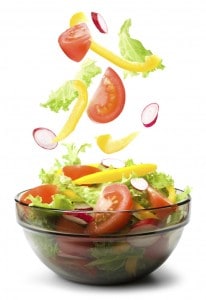
Q. I’m a college student and I try to eat healthy. But with the amount of processed foods in the school cafeteria, it’s almost impossible to avoid eating a lot of sodium. I’m healthy and active with a normal blood pressure and I’ve always considered sodium the least worrisome of the food evils (though high blood pressure does run in my family). I assume that as long as I increase my water intake along with sodium, everything will “balance out” in the body. Is there any truth to this? If so, how much water is necessary to offset 2400 mg sodium over the recommended daily value?
A. First, I congratulate you for making nutrition a priority! Secondly, I sympathize with your challenge of limiting sodium when faced with typical cafeteria food. Thirdly, I agree that because you are healthy, active, and have normal blood pressure, you may not need to worry too much about some extra sodium in your diet.
See also: Is Salt Bad For You?
As for “balancing” the sodium, drinking more water can help prevent water retention due to the high sodium diet. (Ironic, but true.) How much water it takes depends on all kinds of variables: your activity level, the temperature and humidity of your environment, and so on. As a general rule, if you are urinating several times a day and your urine is pale in color, you are adequately hydrated. Keep in mind, however, that certain drugs and vitamin supplements can color the urine.
See also: How Much Water Should You Drink?
Another way to balance a high sodium intake is to increase your intake of potassium.
See also: Sodium and Potassium: What’s the Relationship?
Cafeteria Survival Tips
Finally, a couple of suggestions on how to keep your sodium intake sane, despite the challenges you describe.
1. Salad bar! Most cafeterias offer a salad bar and here, at least, the vegetables are not likely to be drenched in salt. As a bonus, vegetables are a great source of potassium and water! Watch out for salty add-ons like bacon, sunflower seeds, olives, three-bean salad, and mixed dressings. Most salad bars include cruets of oil and vinegar…use those for your dressing.
2. Say no to avoidable salt. You may have to live with a certain amount of sodium in the prepared foods in the cafeteria. But you can opt out of salty but nutritionally empty foods like chips and French fries, right?
3. Campaign for change! Talk to the cafeteria manager (or your student life rep or the school newspaper editor…) and ask if the food service can pay more attention to offering lower sodium options. With the huge public debate going on right now over reducing sodium intake, they should be a little more tuned in to your concern.
Hang in there! You’ll soon have more control over your food choices and it sounds as if you are motivated to make good ones.
